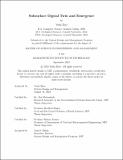Subsurface Digital Twin and Emergence
Author(s)
Zhao, Yushi
DownloadThesis PDF (4.440Mb)
Advisor
Rebentisch, Eric
Hager, Bradford
Juanes, Ruben
Terms of use
Metadata
Show full item recordAbstract
Subsurface characterization stands at the nexus of humanity's growing demands for materials, energy, and safety amid the burgeoning population and rising living standards. However, challenges in subsurface characterization, rooted in conventional practices, functional silos, limited data density, and technological constraints, impede business efficacy and sustainable development. As societies' expectations shift and industries evolve, a paradigm shift is required in the human-machine relationship and the way we organize work. To meet these challenges and ensure responsible human progress, a systematic solution is needed.
This thesis investigates the concept of a subsurface digital twin as a boundary object that bridges disciplines, scales, and uncertainties, fostering collaboration and real-time informed decision-making. It explores the evolution of subsurface characterization from data-sparse and theory-dependent practices to a holistic digital twin framework. The thesis identifies critical technical and sociotechnical challenges, including data scarcity, overreliance on empirical relationships, functional silos, and trust. The thesis demonstrates how a subsurface digital twin can enhance cross-functional collaboration and address critical challenges through real-world examples. It highlights the use of geoanalytics and machine learning to predict total organic carbon content and formation brittleness, showcasing the digital twin's power in multidisciplinary workflows. Furthermore, it proposes a solution for uncertainty reduction through integration and laid out future steps for the development of the subsurface digital model, construction of pseudo/surrogate models for probabilistic simulation complex and time-consuming numerical simulations, and use of the digital twin to bridge workflows between data-rich and data-scarce regions across scales.
The thesis outlines the design and value-creating functions of the subsurface digital twin system, facilitating adaptive resolution and agile implementation. It envisions a future where such digital twins revolutionize decision-making, from individual project optimization to enterprise-wide insights. The thesis underscores the importance of strategic investment in digital twins for long-term returns and as a cornerstone of the evolving human-machine relationship and advances the concept of a subsurface digital twin as a transformative approach to subsurface characterization, fostering collaboration, tackling challenges, and paving the way for sustainable progress in a rapidly changing world.
Date issued
2023-09Department
System Design and Management Program.Publisher
Massachusetts Institute of Technology